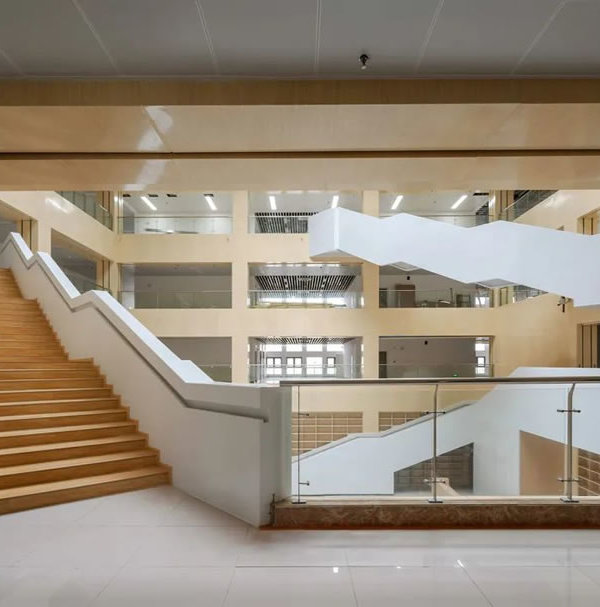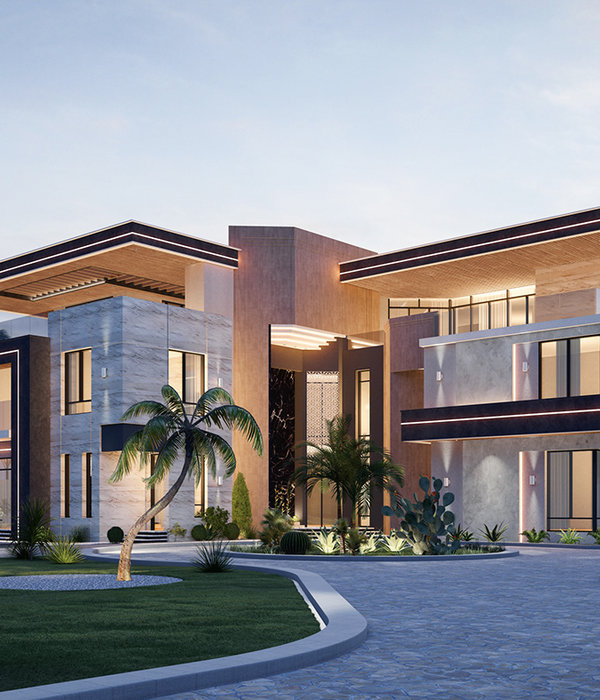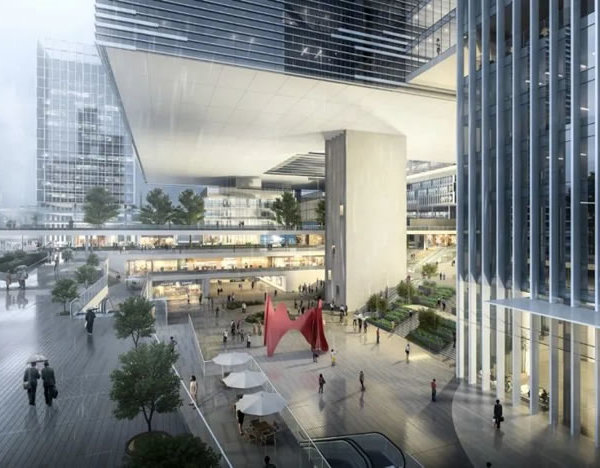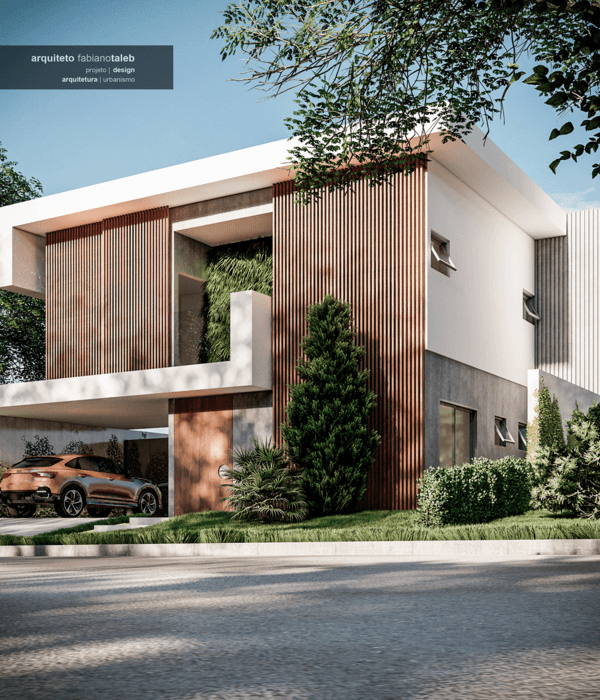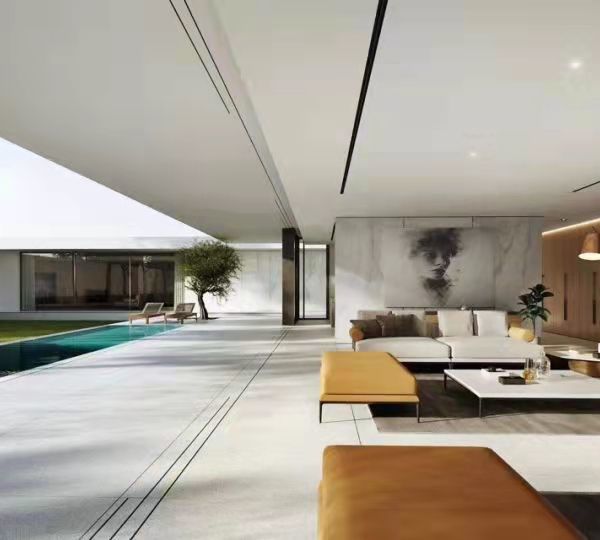这座住宅的名字“Baan Dam”在泰语中表示“黑色的房子”,这来自于其特殊的黑色外观和在最大程度上实现的简约感。
The project holds the name “Baan Dam,” a term chosen for its utmost minimalism, with all those engaged in the journey referring to it by this title. In Thai, “Baan” translates to “House,” while “Dam” signifies “Black.” Hence, it is referred to as the Black House due to its association with this dark hue.
▼项目概览,Preview © Rungkit Charoenwat
房主最初的要求是使住宅体现出清迈当地的特色和精髓,同时又要与现代生活相协调,并尽可能地减少从国外进口的建筑材料。
The initial request from the homeowner was for a residence that embodied the local essence of Chiang Mai, while also being in harmony with contemporary living and minimizing the use of external imports for its construction.
▼建筑外观,Exterior view © Rungkit Charoenwat
▼房屋完全使用黑色,Black is exclusively used in the house © Rungkit Charoenwat
▼景观庭院,The landscape yard © Rungkit Charoenwat
▼水景装置,Water feature © Rungkit Charoenwat
形式和大小不一的庭院构成了建筑的布局特征。最大的庭院是一个景观庭院,建筑围绕着它形成一个U形。该区域可作为户外活动空间,尤其是露营等休闲活动。
The architectural layout featured a variety of courtyards in different forms and sizes. Beginning with the largest, there’s a landscape yard, where the house forms a U-Shape around it. This area serves as an outdoor activity space, particularly for activities like camping and other recreational pursuits.
▼轴测图,Axon © Housescape Design Lab
▼庭院可以进行露营等休闲活动,The landscape yard serves as an outdoor activity space, particularly for activities like camping © Rungkit Charoenwat
▼阳台在庭院和住宅间形成过渡,The balcony connects the courtyard to the main house © Rungkit Charoenwat
▼带顶的阳台空间,The covered balcony © Rungkit Charoenwat
▼从阳台望向餐厅和门厅,Dining area and foyer from the balcony © Rungkit Charoenwat
第二个部分是主屋前院,该区域使用烘烤过的黏土作为铺地材料,模仿了泰国人熟悉的传统房屋。这里是通往住宅半公共区域的连接点,包括“Tern”区域和主入口,并延伸至公共用餐区。由于房主喜好烹饪,设计师有意用餐厅取代了传统的宾客接待区域。
The second part is the housescape yard, which is the entryway to the house. This area utilizes baked clay as flooring, mimicking the traditional local houses familiar to Thai people. It acts as a connection point to the semi-public spaces of the house, including the “Tern” area and the main entrance, extending to the communal dining area that replaces the traditional guest reception room. As the homeowner enjoys cooking, the significance of hosting guests in this house lies in the arrangement of the dining space.
▼主屋前院,The housescape yard © Rungkit Charoenwat
▼客厅,Living room © Rungkit Charoenwat
▼餐厅替代客厅成为主要接待空间,The significance of hosting guests in this house lies in the arrangement of the dining space © Rungkit Charoenwat
▼厨房吧台,Kitchen bar © Rungkit Charoenwat
▼用餐区,Dining area © Rungkit Charoenwat
最后,走廊庭院部分是一个小型的私密空间,它通过一个小天井空间进行遮挡,并提供了与主屋分离的、通往主卧室的通道。
Lastly, the corridor yard is a small, private space screened by a small yard. It serves as a pathway leading to the main bedroom, separated from the main house.
▼走廊,Corridor © Rungkit Charoenwat
主卧室区域安装了局部的木质推拉窗,通过紧凑的空隙创造出私密的氛围。虽然布局紧凑,但浴室和卧室之间没有设置任何隔断,为的是为房屋打通流畅的动线。与此同时,精心考量的布局使功能空间的位置更加合理,避免了不同空间产生的冲突。
Within the primary bedroom area of the house, there are local wooden sliding windows incorporated to establish a sense of privacy through compact voids. In this compact building, there won’t be any doors separating the bathroom and the bedroom. The architectural layout is carefully designed to encourage a seamless flow, strategically positioning functions to avoid direct confrontation.
▼卧室,Bedroom © Rungkit Charoenwat
▼浴室,Bathroom © Rungkit Charoenwat
▼浴室细节,Bathroom detailed view © Rungkit Charoenwat
▼屏墙细节,Screen detailed view © Rungkit Charoenwat
在清迈这样一个湿热且多雨的地区,需要重点考虑遮阳蓬的设计,因为它将对创造舒适的环境起到基础性的作用。由于需要完全使用黑色,而当地找不能够大规模生产黑色瓦片的工厂,为此设计团队通过当地工匠所掌握的技术,为该项目单独粉刷了近2万块屋瓦并以传统方法进行排列。屋顶被分为两个部分,并用混凝土板屋面进行连接,以防止接缝处的漏水和渗透。
▼黑色的屋顶和墙体,The roof and wall surface with dark hue © Rungkit Charoenwat
In hot and humid regions with heavy rainfall like this, shading is of utmost importance as it creates a comfortable environment. This is a fundamental consideration in architectural design. However, the choice of roof for this specific house differs from our past practices. We need to use black exclusively. Hence, due to the local production of cement tiles, we cannot find large-scale factory-made black tiles. Thus, our team had to individually paint nearly twenty thousand tiles for this project, employing techniques known to local artisans. These tiles will then be arranged using a method familiar to local craftsmen. The roof will be divided into two sections and connected using a concrete slab roof to prevent excessive seams that might result in leaks. These seams could lead to water infiltration.
▼夜景,Night view © Rungkit Charoenwat
房屋入口处的黑色墙壁是建筑外观的一个显著特点。这种被当地人称为“Salad Dok”的深纹理墙面直接面对着正午的阳光,在光线的映衬下,由当地工匠打磨的每一处复杂细节都尽数展现在眼前。
The standout feature on the exterior is the black wall at the entrance of the house. For this, we employ a deeply textured wall surface known locally as “Salad Dok,” as this black wall directly confronts the midday sunlight. It reveals every intricate detail of the local craftsmen’s ornaments as it interacts with the sun’s rays.
▼入口区域,Entrance area © Rungkit Charoenwat
▼材料细节,Material © Rungkit Charoenwat
▼入口顶篷,Canopy at the entrance © Rungkit Charoenwat
▼鸟瞰,Aerial view © Rungkit Charoenwat
▼入口夜景,Entrance night view © Rungkit Charoenwat
▼门厅天花细节,Ceiling in the foyer © Rungkit Charoenwat
▼建筑夜景,Night view © Rungkit Charoenwat
▼设计手稿,Drawing © Housescape Design Lab
▼设计草图,Sketch © Housescape Design Lab
▼立面图,Elevations © Housescape Design Lab
{{item.text_origin}}


